Whisper vs Google Speech-to-Text: Choosing Between Voice-to-Text AI Solutions
January 18, 2025 • 1545 Views • 33 min read
Tetiana Stoyko
CTO & Co-Founder
Voice recognition features are growing in popularity. Such software solutions were highly complex and expensive to produce and integrate for a long time. As a result, such functionality was offered by a limited number of tech giants like Apple or Google Cloud speech-to-text.
However, with the emergence of AI, access to such functionality became affordable.
Regarding our latest custom software development service projects, we decided to research the recent market demand and offers for such features, as well as which existing solution will be affordable yet efficient.
Long story short, we narrowed the list of potential integrations to 2 main options: Google Speech-to-Text AI and OpenAI Whisper speech-to-text solution.
However, before deciding which is best, we have to discuss Automatic Speech Recognition (ASR) systems, as well as the strengths and weaknesses of each mentioned software.
Voice-to-Text Solutions In a Nutshell
First of all, what is so special about Voice recognition solutions?
Simply put, such software solutions are designed specifically to:
- record and process sound,
- transcribe voice commands into text,
- recognize requests and perform them.
For example, Apple’s Siri and “Ok, Google” are among the most popular and famous solutions in this niche. They are activated by a certain voice order, such as “Hello, Siri” or “Ok, Google,” respectfully, and after activation, they can perform user requests.
To illustrate, you can ask Siri to play a particular song on Spotify while driving without distraction or interacting with the phone. Alternatively, you can ask Google about the weather outside while choosing what to wear.
Long story short, voice recognition features help you perform digital tasks without stopping any process you are engaged in. But why are they called Voice-to-Text solutions?

Unfortunately, even the most advanced software can’t process and perform voice orders.
Thus, software developers decided to utilize voice recognition by transcribing it into text commands to enable such functionality. Unlike sound, systems can easily recognize them and perform required tasks.
As was mentioned before, ASR systems were complex and expensive to develop and maintain. Therefore, the most popular solutions on the market are primarily offered by tech giants:
- Siri by Apple
- Amazon Transcribe/Alexa
- Google Cloud speech-to-text
Nevertheless, the success of OpenAI and its services like ChatGPT created a chance to change this market for good.
To be more accurate, we are talking about OpenAI Whisper speech-to-text solution, an innovative open-source speech recognition and transcription system.
Pros and Cons of Google Speech-to-Text
First of all, Google's ASR system is distributed as a service. Unlike other alternatives like Whisper speech-to-text AI, it requires minimal coding or IT infrastructure setups.
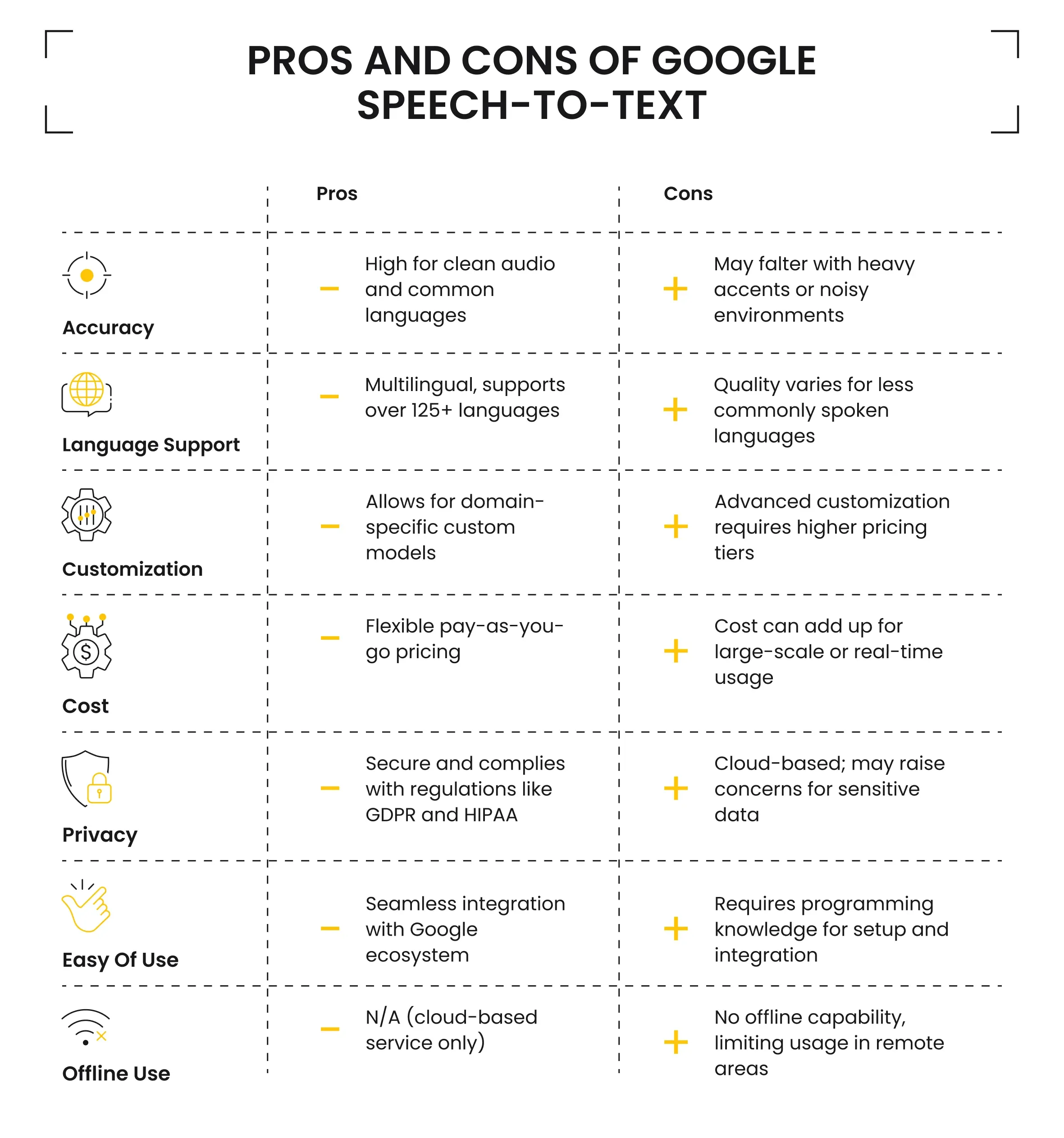
Benefits of Choosing Google’s ASR System
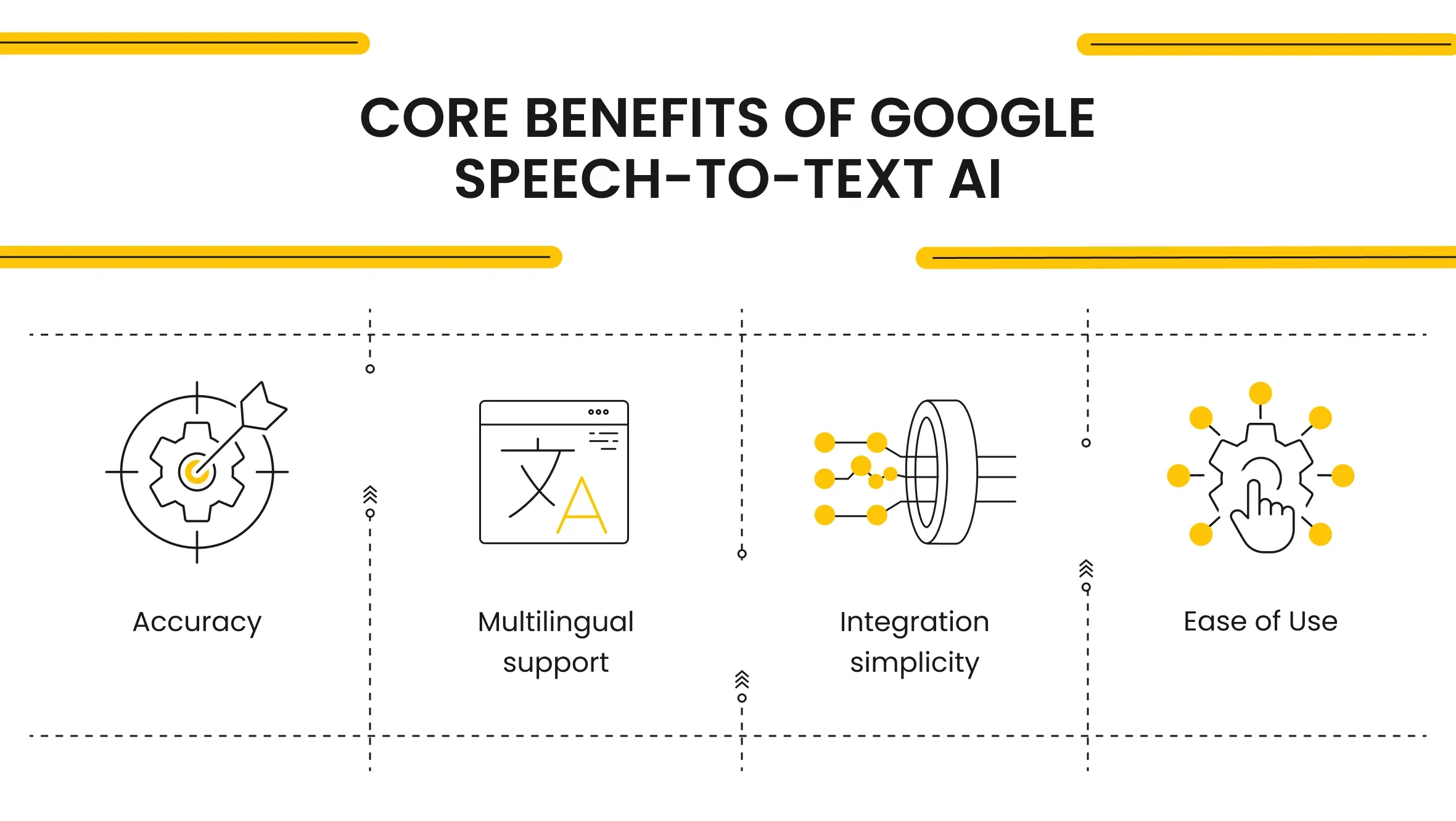
Frankly, there are a lot of advantages to this SaaS solution. The shortlist of the most valuable benefits of Google Cloud speech-to-text system includes:
- Accuracy
- Multilingual support
- Integration simplicity
- Ease of Use
Accuracy of Speech Recognition
This model design and creation took place long ago, compared to many alternatives. Therefore, its developers had a chance to test and optimize it, as well as scale the functionality.
Currently, Google Cloud speech recognition tools show excellent results in defining, transcribing, and processing speech.
It can also distinguish background noises and ignore them, focusing on the closest voice source, making the transcription more accurate.
Besides, Google’s solution can be customized by adding filters like filtering our profane or inappropriate language.
Finally, this software can listen to dialogues, identify different speakers, and transcribe them respectfully.
Long story short, Google Cloud Speech-to-Text AI tool is the new-era solution in the field of voice recognition. Still, many of its advantages are possible thanks to previous variations of this ASR system and its algorithms.
Yet, it is hard to argue that it is one of the most accurate and advanced speech-to-text transcriptors on the modern market.
Multilanguage Support
Another crucial advantage to consider Google’s solutions for developing speech-based services is its multilanguage support.
While most modern alternatives have a lot of resource limitations and train their models on just a few of the most common and popular languages like English, French, or Spanish, Google can afford to train the multilanguage model.
This means that Google Speech-to-Text AI not just offers its users an enormous list of languages to choose from. They also spend time and resources testing and training their AI model, ensuring it can recognize and correctly transcribe suggested languages.
Thanks to this feature, Google’s speech recognition AI deals with many other competitors, allowing global and local businesses to enable Voice-driven user interfaces in different regions worldwide.
Locals can speak and understand the language of their origin. Unfortunately, many might not speak or understand the most popular and spread languages like English or Spanish.
So, while most alternatives to this speech-to-text AI can be used for a limited target audience, which is primarily narrowed down to a few nations or ethnic groups, Google Cloud speech-to-text can be easily used to provide the same services to a more diverse TA, making it a preferred choice among many local businesses (it supports around 125 languages and dialects).
Integration Simplicity
Another critical point is the simplicity of integrating and setting up this service.
Like any other software solution by Google, this AI is distributed as software-as-a-service, requiring minimal actions to be performed before starting to use it. It is a ready-made software product that can be easily integrated, thanks to official guides.
Apart from that, this speech-to-text tool is a complex product using internal resources. To rephrase, it requires very little preparation and doesn’t require extending your hardware or software systems, adjusting and redesigning your IT infrastructure, etc.
So, companies don’t require much time and resources to integrate and customize their Google Speech-to-Text AI. Moreover, you can start using its full potential almost immediately after integration.
Finally, the service provider (Google) manages all the support and maintenance. Thus, businesses don’t need to maintain a development team on hold.
The only way they can and should participate in AI maintenance - is to report bugs or make suggestions to the provider. As simple as that.
Ease of Use
The last but not least advantage of this solution is the ease of use. Like many other Google products, it offers relatively simple and convenient user interfaces that require almost no time to get used to.
This overall simplicity is applied to all parties that interact with Google voice-to-text service.
For instance, product owners can customize, manage, and track various working aspects of the AI in special consoles and dashboards, making it easier and faster to set up the environment.
At the same time, it enhances and simplifies users' lives, ensuring they have a seamless experience and a clear understanding of how to use and operate this service. Such a personalized approach increases the chances of ensuring that users will know how to and want to use voice commands.
In other words, you can learn more about user behavior and discover whether they need such features firsthand, knowing that using such a tool is very easy.
Drawbacks of Working with Google’s ASR
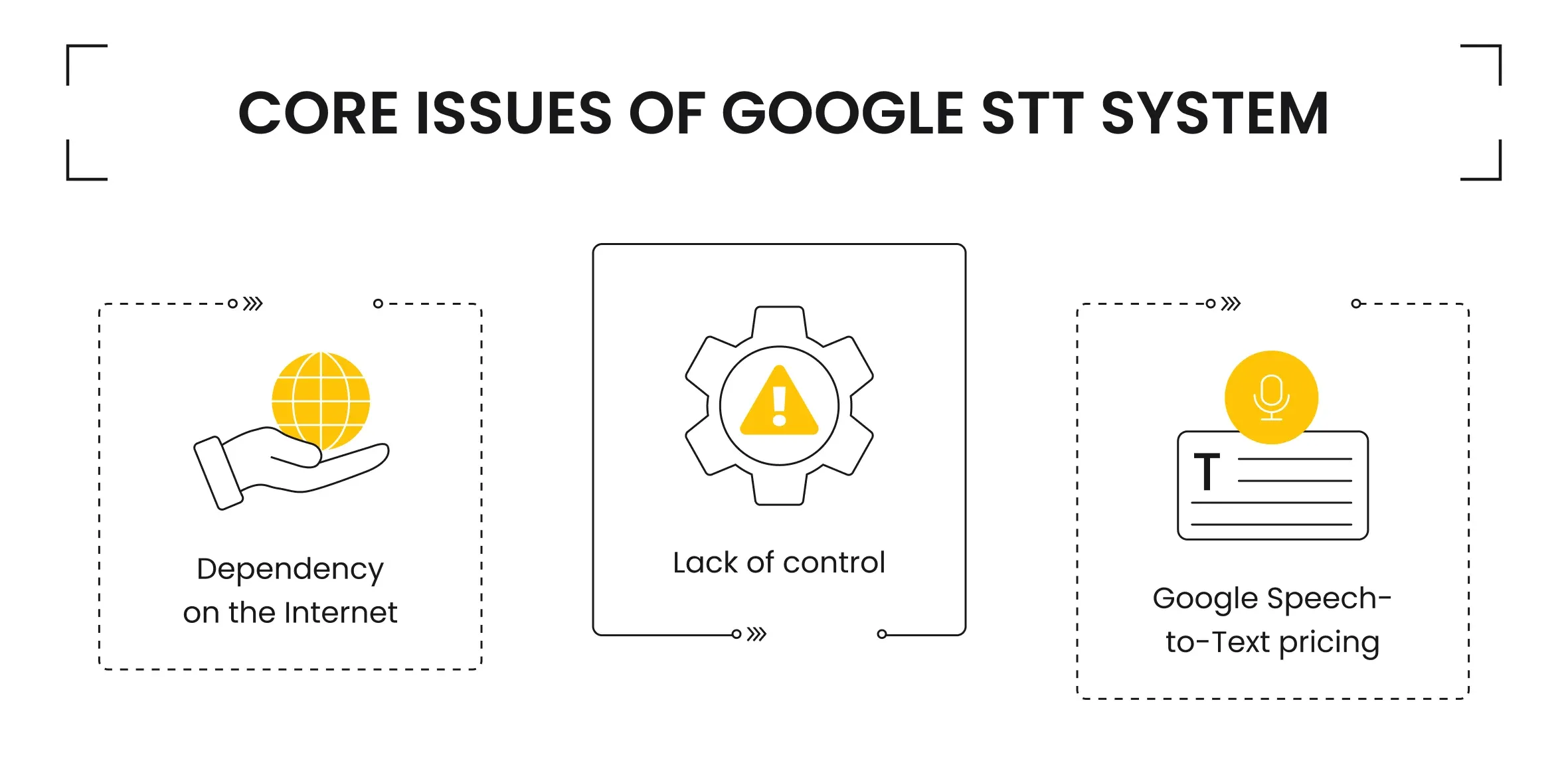
Despite all the benefits and overall simplicity of this voice recognition AI solution, it also has a list of challenges worth considering. The main drawbacks of Google’s voice recognition system include:
- Dependency on the Internet
- Lack of control
- Google Speech-to-text pricing
Internet Dependency
One of the service’s core features has a significant drawback. On the one hand, Google’s Voice-to-text requires no IT infrastructure because it is hosted on Google Cloud. However, it is highly dependent on the quality of the Internet connection.
This service processes input data and requests online, making enabling it offline almost impossible.
Therefore, users might face issues using this service in uncertain or unpredictable situations. For instance, voice requests on the road might be complicated when an Internet connection can be tricky.
Lack of Control
Another issue related to Google Cloud speech-to-text is the lack of control over this service.
Once again, it is a result of previously mentioned benefits. On the one hand, developers and business owners don’t have to maintain and support such complex software.
However, they also can’t implement changes and make advanced adjustments that are potentially needed to improve the services offered.
Unfortunately, this brings a lot of limitations to the table as well. For instance, you can (and most likely will) notice some aspects that can be improved to increase the efficiency of Google Cloud speech recognition.
However, you won’t be able to make any code-based or advanced settings using a SaaS solution.
Additionally, when facing bugs or other issues, you’ll have to report them and wait for the software vendor to fix them on their side.
Google Speech-to-Text Pricing
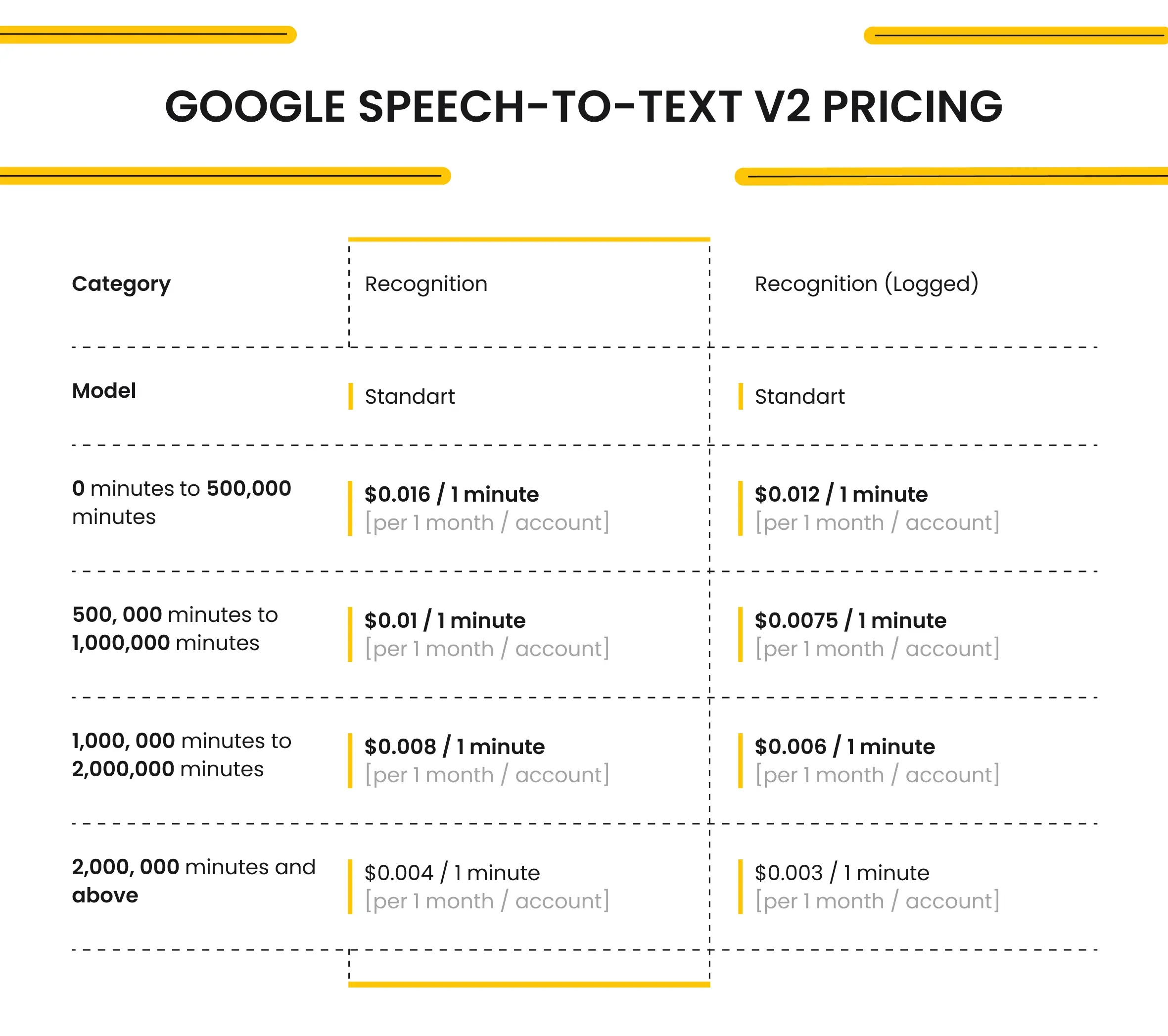
Frankly speaking, it is hard to estimate precisely how much it will cost you because the final price for Google Speech-to-Text varies depending on the scale of services used and the specifics of the voice recognition model.
At the moment, they offer three different options:
- Speech-to-Text V1 API
- Speech-to-Text V2 API
- Medical Model
We can make an approximate calculation based on the prices stated on their official website.
We want to enable an optional voice recognition and ordering feature for a food delivery application with approximately 10,000 active users daily. The feature is optional, so not every user will use it. Let’s suppose it's 1000 users daily.
Voice search usually takes up to 30 seconds, while ordering can vary between 30-60 seconds. Integrating voice recognition to enable AI-driven customer support is the most prolonged and expensive part.
Let’s agree that the average session will take 1 to 3 minutes. To simplify all the foregoing, suppose 1000 users use voice recognition features once a day for one minute.
As a result, we will have to pay for 1000 minutes a day, or 30,000 minutes per month. So, the price for Google Speech-to-Text for you is:
0,024 x 30000 = 720$
Yet, we also have to subtract the price for the first 60 minutes because they are free each month:
720 - 0,024 x 60 = 718,56$
However, it is hard to predict the actual number of active feature users and the total number of spent minutes. Besides, the prices also vary: the more minutes are used, the less you have to pay for them.
To sum up, price is tricky when choosing Google Speech-to-Text AI, especially if you are just preparing to present a voice recognition feature.
There are two most efficient ways to have a more accurate vision of potential expenses on Google Speech-to-Text:
- Just integrate it into your software app and test it for some time, gathering data for a few months and then deciding whether it is worth paying.
- Find reliable software development companies familiar with such technologies and ask for technology consulting. They have experience making proper estimations and have already gathered enough data to calculate as accurately as possible.
Pros and Cons of Whisper Speech Recognition System
Now, let’s examine the strengths and weaknesses of Whisper SRS.
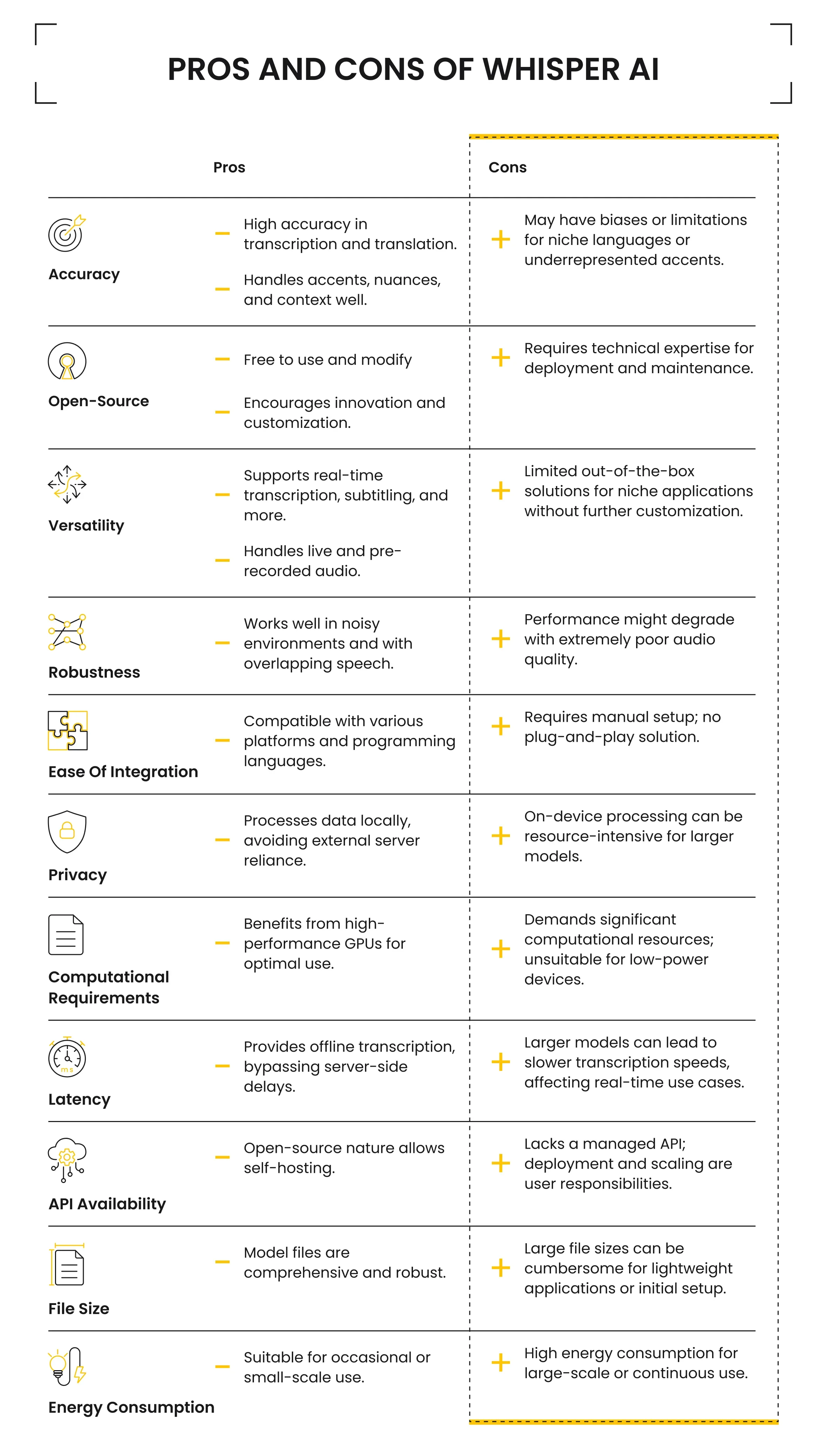
Whisper is an open-source speech-to-text (STT) model designed and developed by OpenAI.
Like Google Speech-to-Text, Whisper offers the possibility of processing voice commands or requests and transcribing them into text format.
Long story short, Whisper shares most of the features and functionality of its rival.
The main difference between them is that Whisper requires a little more experience in software development.
Unlike Google’s solution, Whisper speech-to-text is self-hosted and needs to adjust and set up its IT infrastructure.
On the one hand, it brings extra challenges and costs for businesses, making them find dedicated development teams capable of delivering expected results.
On the flip side, the open-source nature of Whisper AI makes it more flexible and customizable, helping companies to stay more independent from third-party software vendors.
For more detail, let’s consider some core pros and cons of the Whisper STT model.
Benefits of Whisper AI
Whisper is an excellent choice for companies considering voice recognition features that can be adjusted and customized.
Besides, it is an excellent choice for startup companies due to its open-source nature: they have experienced developers on board yet are limited in available resources.
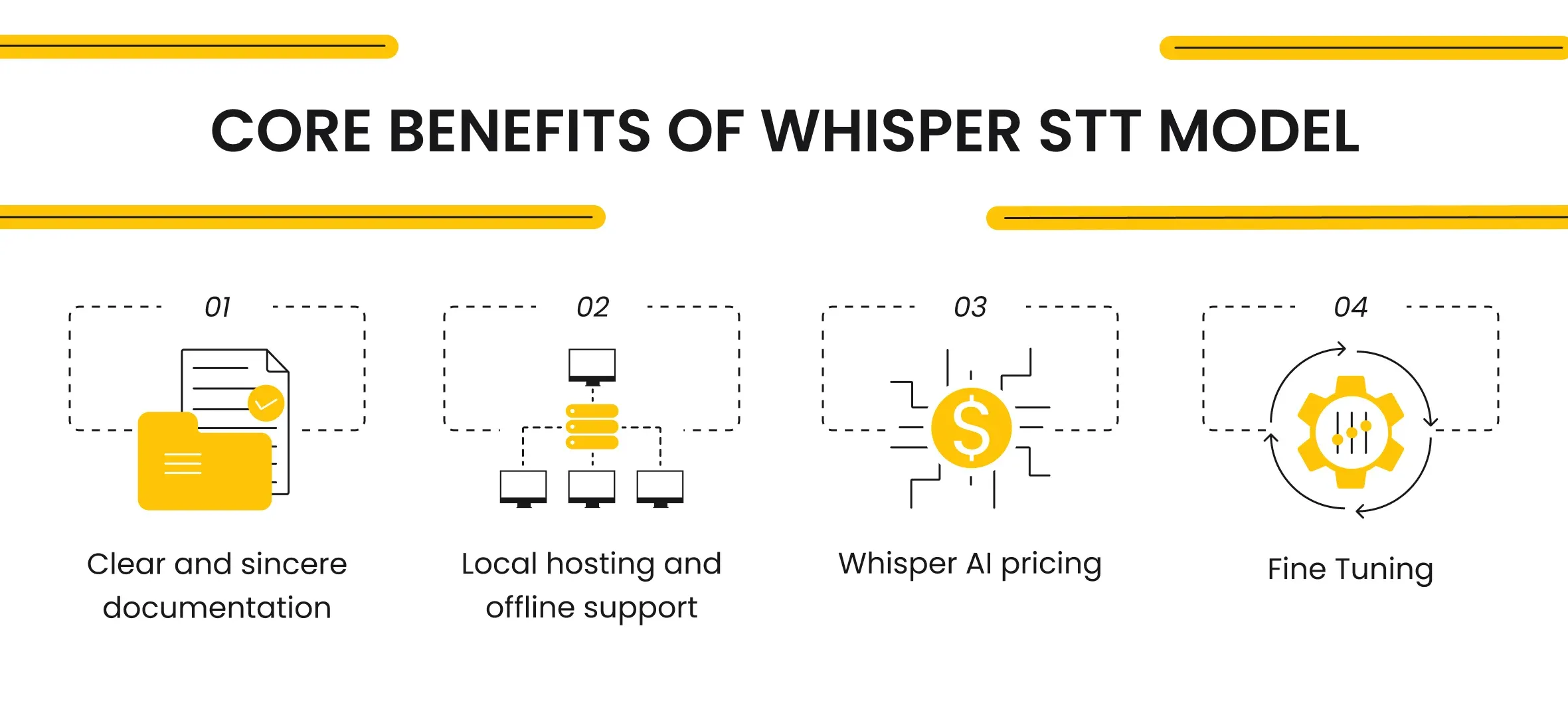
The shortlist of Whisper benefits shares many similar points with Google speech-to-text:
- It supports multiple languages,
- Whisper shows great and accurate transcription results,
- It can recognize background noises.
However, the most interesting advantages of Whisper speech-to-text solution are defined by its open-source nature.
Therefore, let’s skip the part when we discuss the features typical for both STT models and pay more attention to the unique advantages of Whisper AI:
- Clear and sincere documentation
- Local hosting and offline support
- Whisper AI pricing
- Fine Tuning
Clear Documentation
Many open-source software solutions share information and details on how their software works or the underlying driving mechanisms.
Clearly, they won’t give up all the info about their software product, yet when comparing OpenAI Whisper vs Google speech-to-text, OpenAI creators seem more public and open to discussions than Google.
For instance, they briefly describe some common issues of their solution in Whisper’s model card.
They also voice their assumptions on what can cause these bugs and how users can potentially deal with them.
As the ChatGPT jailbreak saga illustrates, OpenAI employees constantly monitor the latest discussions or articles about their products, trying to improve or prevent them from doing something (even though they mostly did the last one).
So, when comparing OpenAI Whisper vs Google speech-to-text, we must admit that OpenAI shows much faster responses and keeps its customers more informed on specific aspects of its products and performance.
Local Hosting and Offline Support
Whisper is open-source, i.e., its owners share the code freely, allowing everyone to use it if needed.
However, apart from being free, this approach suggests enabling functionality on the code level.
So, while Google Speech-to-Text is based elsewhere on the cloud, Whisper can be located directly on the device or cloud, depending on your preferences.
This creates a significant advantage over similar SaaS solutions, allowing users to utilize voice recognition regardless of the Internet connection or other extraneous causes.
It is hardly an advantage if your application depends on an internet connection like the eCommerce platform.
However, if your app supports both online/offline usage, it will be a noticeable advantage.
Besides, local hosting offers another important feature - you have complete control over the input data and infrastructure.
First, it helps ensure better security, avoiding the need to share data with third parties.
This can also be an additional advantage on the legal level: for instance, it helps meet the GDPR requirements and reduces the paperwork related to user data access and ways to process or share it.
Secondly, Whisper local hosting reduces your dependency on third parties and service providers by giving you all the required tools and permits to implement changes or process data independently.
Whisper AI Pricing
Finally, let’s talk about the Whisper AI cost. As an open-source solution, Whisper is free of charge, meaning you can integrate and use it for free, regardless of the scale or complexity of requests to process.
Nevertheless, it is not entirely accurate. Whisper requires efficient infrastructure and hardware solutions to work correctly.
In the case of local hosting, you will have to spend some money on hardware setup, impacting the Whisper AI cost. Mainly, it requires an efficient CPU and GPU.
Still, consider it a one-time purchase: when you gather a recommended setup, all you have to pay for - is electricity.
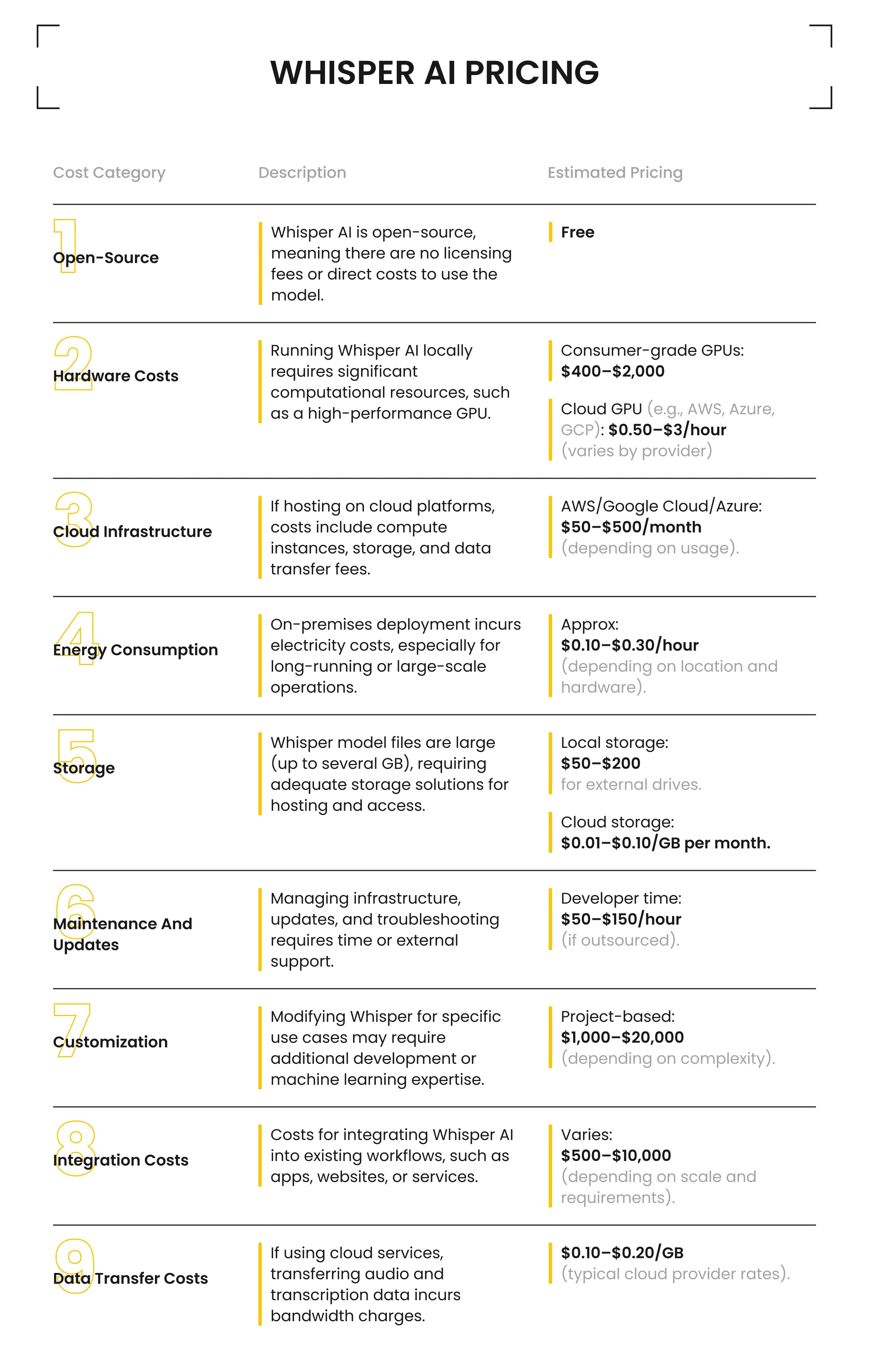
If you are considering choosing the cloud-based model, you will have to pay a few cents per minute, depending on the cost of your chosen cloud infrastructure.
Finally, to ensure the accuracy and efficiency of your Whisper-based voice recognition services, you must first perform some training like fine-tuning.
This is among the most expensive parts of the setup, which can vary from 100$ up to several thousand, depending on the complexity and scale of training.
Still, fine-tuning is not a must-have step, and you can skip it if your use purposes don’t have any unique or specific requirements and demands.
Whisper Fine Tuning
Fine-tuning is an excellent and unique feature offered by Whisper. It allows you to train the Whisper STT model to recognize any sound you like.
Fine-tuning trains a model by feeding it with sound files and their text transcription. It is a resource-intensive process that requires a lot of preparation.
However, this creates prosperity for making a customizable and personalized speech-to-text model. For instance, you can train it to translate barks or teach him elvish.
However, don’t forget that you must prepare a dataset of sounds and their explanation to ensure the efficiency of voice and language recognition.
Thanks to the fine-tuning option, developers and businesses can use speech-to-text for multiple purposes, starting with pure entertainment and ending up with some scientific researchers or other use cases.
Challenges of Whisper STT Model
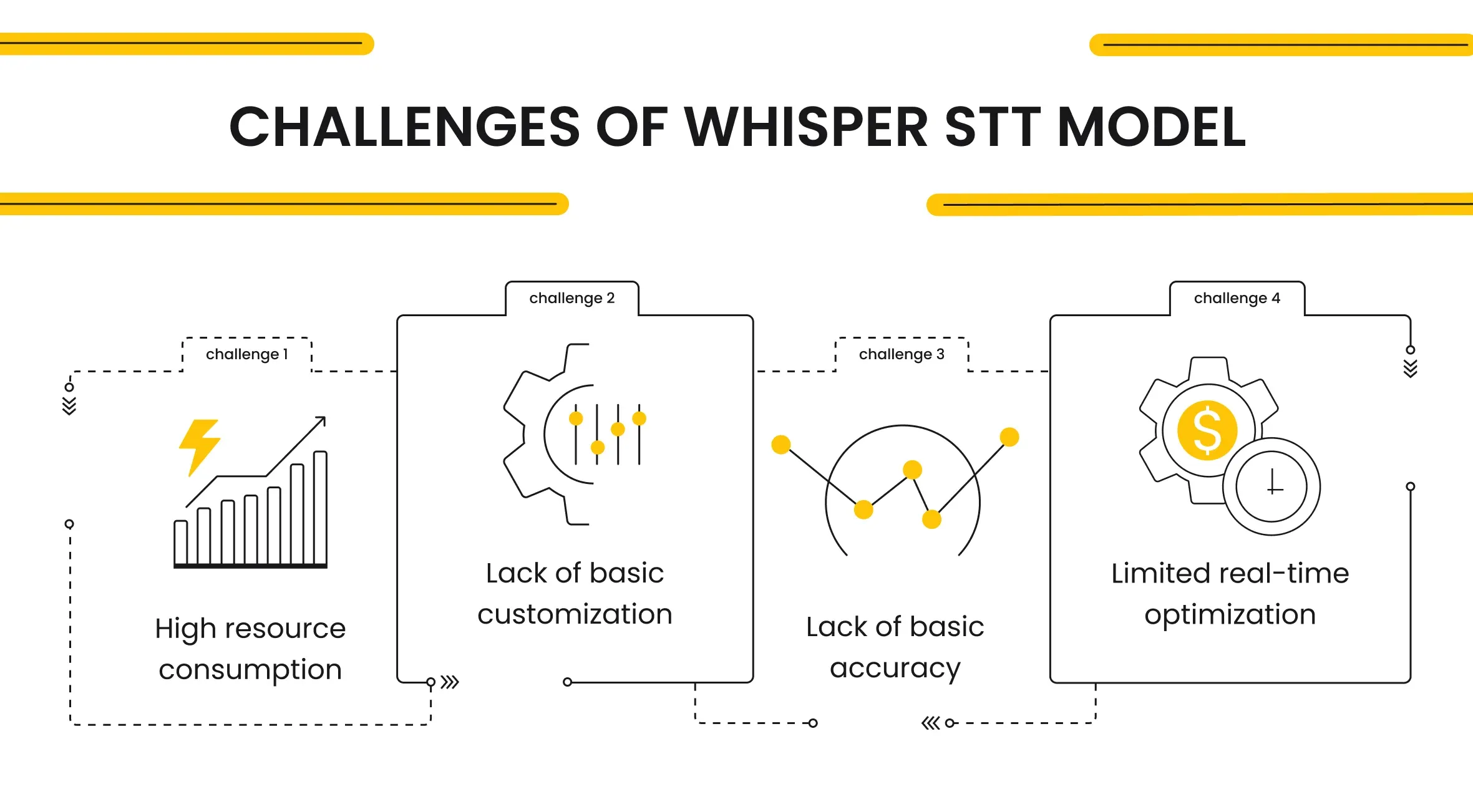
Apart from its benefits, Whisper speech-to-text has a few challenges that you must overcome to use it successfully. Simply put, the core Whisper challenges include:
- High resource consumption
- Lack of basic customization
- Lack of basic accuracy
- Limited real-time optimization
Let’s briefly examine each of them and the possible ways to deal with these issues.
High Resource Consumption
Whisper model is quite resource-intensive and demands a lot of computation power.
The lack of required computation resources may significantly reduce Whisper's efficiency and speed.
Nevertheless, it can be quickly resolved in a few ways:
- Migrate Whisper to cloud services. It will increase the expenses on operational costs yet easily satisfy the demand for computation power.
- Upgrade your hardware. Unlike the previous solution, it assumes a one-time purchase, whether it is scaling your CPU, GPU, or both.
Unfortunately, each solution also brings some issues.
For instance, migrating to the cloud makes you dependent on an Internet connection, while hardware improvement might be physically limited or even impossible.
Lack of Basic Customization and Accuracy
As was mentioned before, fine-tuning is optional, and you might skip this step.
Yet, we strongly recommend spending some time and resources on this process. Otherwise, you will have to use a basic version of Whisper AI.
If not tuned, Whisper speech-to-text solution might show mediocre results and make mistakes during transpiring requests.
Nevertheless, spending time and some money on fine-tuning helps fix and enhance the efficiency of voice recognition and personalized speech-to-text recognition.
For example, you can train it to distinguish different accents or dialects.
Therefore, we believe such expenses are justified and should be included in the initial price of integrating Whisper AI.
Limited Real-Time Optimization
One of the most challenging issues of Whisper AI is the limitation of real-time processing and optimization.
Unfortunately, this issue can’t be fixed now, and users are forced to wait for the Whisper developers to find ways to improve the real-time responses.
Nonetheless, businesses can still train the STT model to slightly speed up the response time and enhance the request processing time and accuracy.
Once again, the best way to achieve such results is to perform fine-tuning.
Frankly, fine-tuning is an excellent instrument that companies can use constantly to improve the overall efficiency of voice recognition and increase the number of offered services.
Whisper vs Google Speech-to-Text: When to Choose Each?
So, which should you choose between two STT models and why?
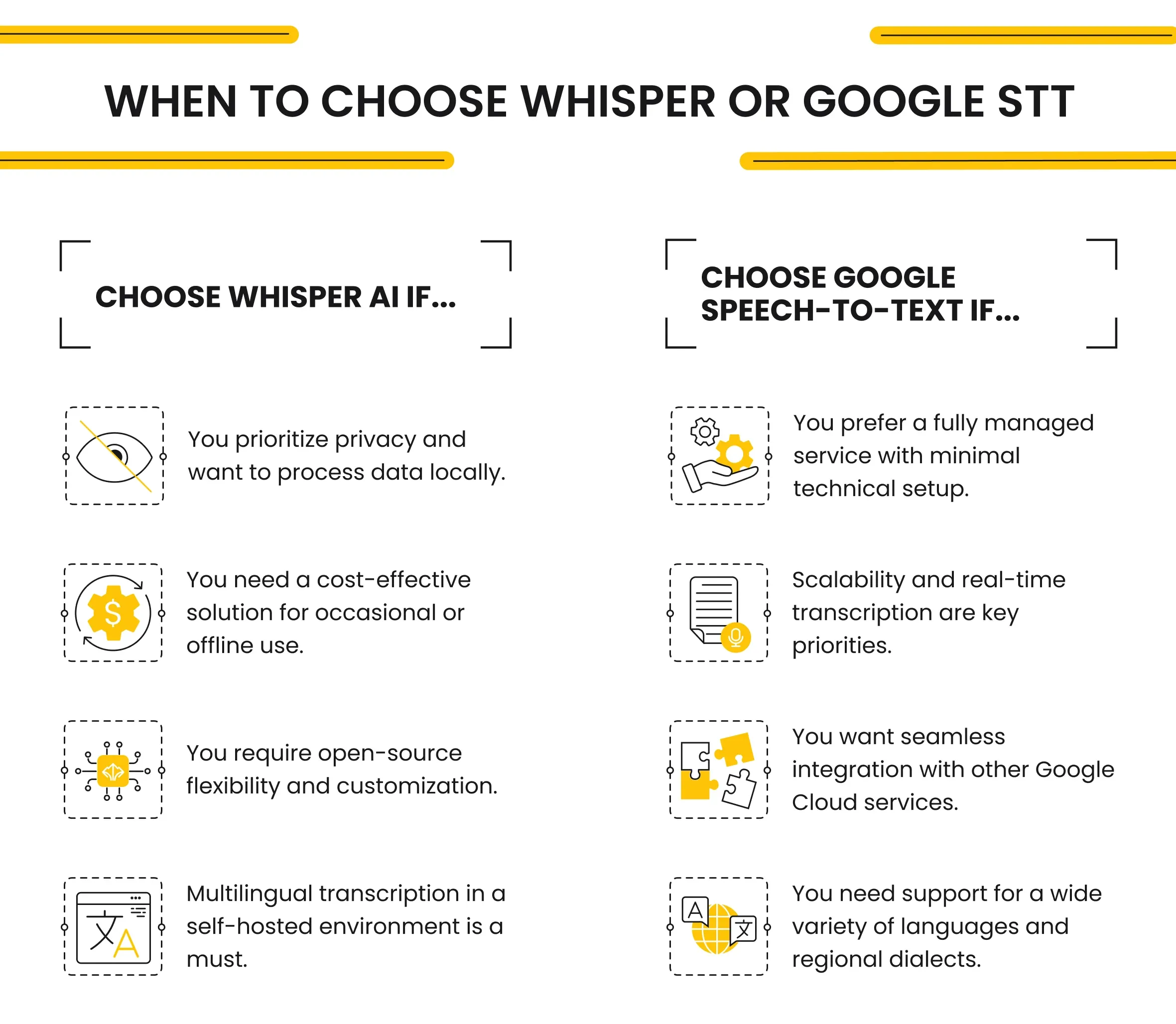
To simplify it, both Google Speech-to-Text and Whisper AI are great solutions.
However, their pros and cons conflict with each other, and their strengths and weaknesses are great for different cases, making you consider which to choose: Whisper vs Google speech-to-text solutions.
Google Speech-to-Text Use Cases
Google voice recognition services are an excellent choice for cases requiring a fast and efficient solution that can be easily integrated and used immediately.
Like any other Google service, it is highly intuitive and easy to monitor. This gives them extra points when comparing OpenAI Whisper vs Google speech-to-text.
Nevertheless, choosing Google Speech-to-Text will be much more expensive to operate despite the progressive fee, which decreases based on the overall number of minutes to process for a month.
Fortunately, due to the high competition for such services, Google commonly offers grant programs like the Google Ukraine Support Fund or various startup discounts and trials.
Thus, finding a program that will help you save significantly on expenses is possible.
To sum up, Google speech-to-text is an excellent choice for small companies and startups who lack tech expertise or can apply for financial support from Google.
Also, it might be a helpful tool for enterprise-level organizations due to the progressive fee.
Yet, your organization must process more than 1 or 2 million minutes monthly to get a discount. In such cases, you must pay at least 8000$ per month for using Google’s voice recognition SaaS.
Whisper AI
Despite all the benefits and discounts here at Incora, we firmly believe that choosing Whisper AI is a much better approach.
Thanks to its open-source and free-of-charge nature, Whisper allows you to cut your spending to a few one-time investments, like buying appropriate hardware solutions, fine-tuning, and hiring a software team extension specialist.
Clearly, all these preparations will require some initial budget and some time for model training and integration.
Nevertheless, the end software product will show much better, more flexible, and cost-efficient results.
Besides, voice recognition, based on Whisper AI, can quickly scale, barely impacting the final costs.
To prove our point, buying enough CPU and GPU and spending on fine-tuning to enable your app to process 1-2 million minutes per month will cost you much less.
For instance, if you locally host it on-premises, you will have to spend around 2000-5000$ per month, while hosting it on the cloud will require only 600-1200$ monthly.
The only cost we should also add - is the salary of the developers, who can integrate and set up your Whisper API to work correctly and satisfy your demands.
Yet, it will be one-time spending: after setting up Whisper for your business, you won’t require a full-time developer to maintain and support the software.
Your in-house team will most likely be able to perform all the necessary practices to ensure the efficiency of the voice recognition feature.
NOTE:
The foregoing pricing is related to self-hosted Whisper AI. You also can apply Whisper API, which will be more expensive and is based on the same principles as Google Speech-to-Text: you get the software as a service, while software support and maintenance, IT infrastructure, and hardware requirements - the software vendor covers all of it
.Why Choose Incora for Integrating Speech-to-Text Solutions?
We recommend our services because our in-house software development team has a lot of experience working with such solutions, as seen in our case studies.
We have a few specialists who have worked with Voice-to-Text and similar technologies in different cases and scenarios.
Our dedicated specialists will examine your case, listen to your thoughts, and offer you the most suited, efficient, and cheapest way to embody your ideas.
All you have to do is sign the contact form, and we will do the rest.
What’s your impression after reading this?
Love it!
2
Valuable
3
Exciting
1
Unsatisfied
2
FAQ
Let us address your doubts and clarify key points from the article for better understanding.
Which solution is better for multilingual transcription?
Whisper is known for its strong multilingual support, including rare languages. Google also supports many languages but may require customization for specific use cases.
Are both Whisper and Google Speech-to-Text real-time transcription solutions?
Google Speech-to-Text supports real-time transcription directly. Whisper can handle real-time processing but may require additional setup for optimal performance.
How do Whisper and Google Speech-to-Text compare in terms of cost?
Whisper is free to use, being open source, but requires local resources for processing. Google Speech-to-Text is a paid service based on usage, with costs varying by duration and features.
Which is easier to integrate into existing workflows?
Google Speech-to-Text offers APIs with seamless cloud integration, ideal for businesses. Whisper requires local deployment, making it more suitable for developers and offline use.
How do I choose the best STT option for my needs?
Choose Whisper if you prioritize privacy, offline use, or cost-efficiency. Opt for Google Speech-to-Text for real-time applications, scalability, or seamless cloud integration.
you may also like
Let’s talk!
This site uses cookies to improve your user experience. Read our Privacy Policy
Accept
Share this article